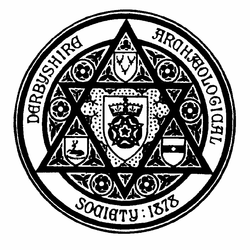Derbyshire Archaeological Journal
Derbyshire Archaeological Society, 2016. (updated 2021) https://doi.org/10.5284/1038992. How to cite using this DOI
Data copyright © Derbyshire Archaeological Society unless otherwise stated
This work is licensed under the ADS Terms of Use and Access.
Primary contact
Susan
Peberdy
Secretary
Derbyshire Archaeological Society
Resource identifiers
- ADS Collection: 2300
- DOI:https://doi.org/10.5284/1038992
- How to cite using this DOI
Derbyshire Archaeological Journal (2017), Volume 137.
Table of Contents
|
Contents
- (pp. ) |
437 Kb | ||
|
Prehistoric monuments in the Peak - an update
Bamatt, J. & Hall, A. (pp. 1-21) |
1 Mb | ||
|
Further excavations at Fin Cop and stable isotope analysis of the skeletons
Waddington, C. & Montgomery, J. (pp. 22-65) |
Abstract | 1 Mb | |
|
An assemblage of Romano-British pottery from Alfreton Road, Derby
Hird, L. & Moore, B. (pp. 66-72) |
616 Kb | ||
|
Roman sling-shots from South Derbyshire
Thomas, R. (pp. 73-75) |
638 Kb | ||
|
Post-conquest activity at Cathedral Road, Derby
Daniel, P. & Grassam, A. (pp. 76-100) |
1 Mb | ||
|
The Portable Antiquities Scheme in Derbyshire
Willis, A. (pp. 101-119) |
1 Mb | ||
|
Fieldwork in Derbyshire by Mercian Archaeological Services CIC, 2013-2015
Budge, D. J. (pp. 120-138) |
805 Kb | ||
|
Corn, wool and paper: mills at Alport-by-Yougreave, from the 11th to the 19th centuries
Burnet, L. (pp. 139-152) |
894 Kb | ||
|
Framework knitting in the parish of Alfreton, 1670-1870
D’Arcy, J. (pp. 153-174) |
756 Kb | ||
|
Bar Brook mills: the transition from smelt mill to slag mill
Goodinson, A. (pp. 175-197) |
Abstract | 2 Mb | |
|
Index
- (pp. 198-202) |
505 Kb | ||





